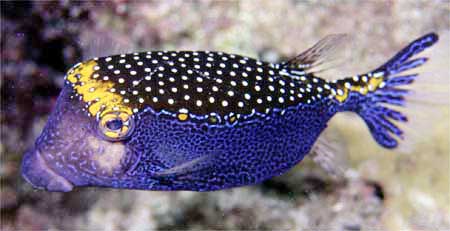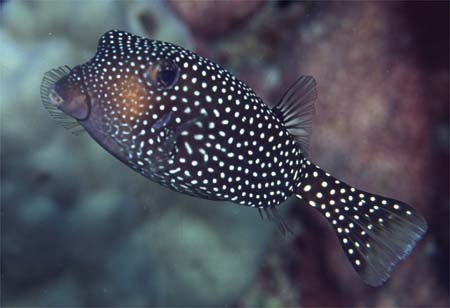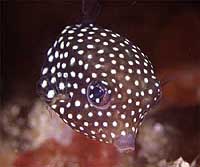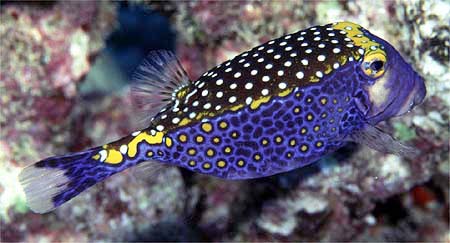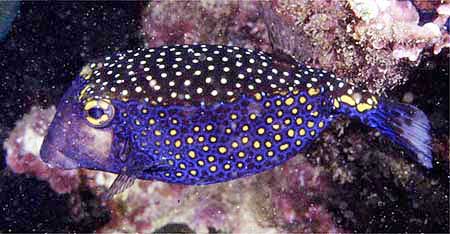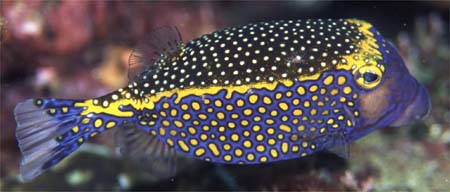|
SPOTTED BOXFISH
· moa
Ostracion meleagris Shaw & Nodder, 1796
This is Hawai`i's most common boxfish.
Females are blackish brown densely covered on all sides with small
white spots. Males have dark blue sides with irregular black spots,
some of which may have gold centers. They also have gold markings
on the head and at the base of the tail. Juveniles with male coloration
are never seen, so either immature males have the female color pattern,
or all juveniles are female with some changing sex later in life.
Spotted Boxfish live in small haremic groups--typically one male
to several females--and forage alone within their home ranges for
sponges, worms, tunicates and other small bottom-dwelling invertebrates.
Males defend territories against other males. These fish often poke
around in the shallows where waders and people walking along shore
can see them.The species name means "guineafowl" (a bird
native to Africa covered with light spots). To about 6 in. Indo-Pacific
and Eastern Pacific.
A subspecies
or not?
Outside Hawaiian waters the black
spots on the sides of male Spotted Boxfish contain conspicuous bright
gold centers. Also, there is a fused line of gold spots along the
upper "corner" of the box. Because most Hawaiian males
lack these gold spots, the Hawaiian population has long been given
the subspecies name camurum. However, males with scattered
gold-centered spots on the sides do occur here, and a few individuals
display enough spots to almost resemble males found elsewhere in
the Indo-Pacific. There is no doubt that the Hawaiian population
is different, but given the presence of intergrades (see photos),
is subspecies status justified? DNA analysis may someday clarify
the situation. However, the concept of a subspecies is not currently
in favor, so if the DNA folks decide that the Hawaiian population
is sufficiently different, Hawaiian fish would likely be considered
a full species with the name Ostracion camurum. Here are
some photos of Hawaiian males with an unusual number of gold spots.
At bottom, for comparison, is a typical male from Indonesia.
|
|
Reproduction
Ichthyologist Phillip Lobel, working
on Johnston Island (where the Hawaiian subspecies also occurs),
records that Spotted Boxfish spawn in the late afternoon or early
evening. A male, whose territory usually encompasses those of several
females, initiates courtship by circling and nudging one of his
females. If she responds, the two swim side by side for a time before
rising 6 ft. or more above the bottom, the male leading. Assuming
a side-by-side position with tails together and heads facing slightly
apart, they release their gametes while one or both make a low pitched
humming sound lasting about 6 seconds. When done they dash back
to the bottom where the male begins courting another female. At
such times other males may attempt to "sneak" a spawn
or disrupt the proceedings; fights are common, the rivals ramming
each other with their armored bodies creating audible bumps and
sometimes producing a short buzzing sound.
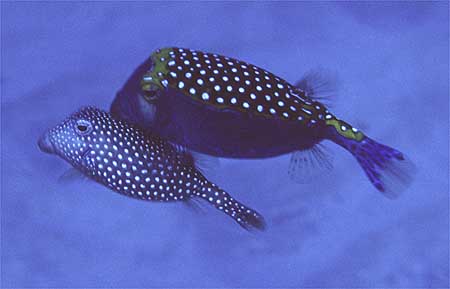
Spotted Boxfish courtship - Halona Blowhole, O`ahu.
25 ft.
|
